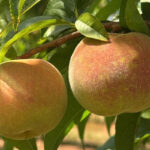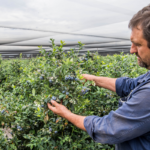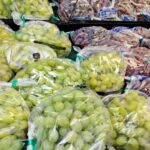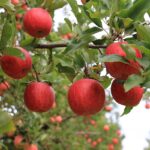Budding overseas empire for Australia's Queen Garnet super plum

The palpable buzz around an anthocyanin-rich Queensland-bred plum is spreading internationally, with commercial growers in Spain and the U.S. set for their first heavy crops of the fruit within a few years. Meanwhile, plant material for the Queen Garnet (QG) has successfully passed through quarantine in South Africa, the process is ongoing in New Zealand and negotiations are underway with potential partners in Chile. By the time significant volumes are grown outside of Australia, human trials into the variety's effects on metabolic syndrome and thrombosis will likely be completed.
"The fruit tastes bloody good," says Benoit Escande in a linguistic nod to the variety's origins in rural Australia. En route to a plantation in northern Spain, the Frenchman explains how the development of a European base for the variety has been seven years in the making.
"We did some testing confidentially and saw that it was a very interesting and promising variety, so we planted around 20 trees to see how it would go," says Escande, from the nursery Pépinières Escande in Saint-Vite.

Benoit Escande says most people who try the Queen Garnet Plum don't just take a bite. They eat the whole fruit to the pip.
"Then we made the application for the EU patent and decided to take the next step by planting commercial orchards. This spring we planted four hectares of the plum in northern Spain - it will grow this year and we expect to have some fruit for harvest in 2016 and 2017."
He says there is a possibility of planting more large orchards over the next three or four years, but everything will depend on the Spanish orchard's performance and whether Pépinières Escande can find the right partners.
"It's a wide-adapting plant. We've tested it in different climates and conditions already, and we were very pleased with what we saw.
"We do need to know which plum variety would pollinate and be compatible with the Queen Garnet, as you have to be able to pollinate at the same time every year even if the conditions are different, no matter how many chilling hours you've had."
He says "everyone" who has tried the fruit enjoys it.
"They don't just take one bite and say 'that’s nice'. They eat the whole fruit to the pit.
"The dark, red purple flesh is unusual...so dark with so many antioxidants, but it's very sweet.
"I have more than 80 varieties in a large selection of plums here in France – I've been in this job 20 years, long enough to have an idea of what I'm talking about, and I've been very impressed with the quality of the tree. It's easy to grow, it sets roots well.
He says while a lot of people are excited about the Queen Garnet plum and want testing plants, the nursery does not want to "lose control" of the trees.
"We can only work with people with a high potential who are very capable of finding a good value to penetrate the market, and have a desire to grow this fruit properly.
"We are not interested in people who will not respect the fruit, who will pick it two weeks early just to enter the market. We want people who can really take pleasure in this fruit."
He adds the fruit tends to start ripening in mid-August in France, and will likely mature during the first week of August in Spain.
'Aggressive caution' in the U.S.
Washington State-based Cameron Nursery entered talks with the variety's owners Nutrafruit around six years ago, and owner Todd Cameron says planting has started in the last two years.
"The Queen Garnet is under testing in the USA by selected commercial growers in ideal growing districts," he says but won't mention exactly where that might be or which companies are involved. Confidentiality is paramount for Cameron, as growers keep their cards close to their chests while they wait to see how the cultivar performs.
"We're hoping to see a bit of fruit this season, followed by much heavier crops next. Plant material is established in sufficient quantity to commercialize Queen Garnet very rapidly."
Cameron was drawn to the variety by its high anthocyanin content, which is five times the level of regular plums and has shown positive results in reducing obesity rates in rats.
"Everyone seems to be paying more attention to their health," he says.
"Market development will be purely based on its performance. Stonefruit's adaptability to a particular climate is really critical, so we'll see how it performs in the orchards and then decide what to do next."
So does this mean Cameron Nursery is taking a cautiously optimistic approach?
"You could say we're being cautiously aggressive. We're ready to make substantial planting; the people that are planting are very large growers."
Expanding Southern Hemisphere production
Nutrafruit director Hugh Macintosh says his aim is to be able to supply the global market with fresh Queen Garnet plums for as close to 12 months a year as possible.
"I don't think it’s ever going to be exactly 12 months but if we can get 10 months it'd be doing pretty well," he says.
Spanish and U.S. production will certainly go a long way in supporting that goal, but growers in three of the Southern Hemisphere's leading horticultural nations also have the variety in their sights. The most advanced of these is Stargrow in South Africa.
"It's only been released from quarantine recently, so we're in the propagation phase now to be able to plant out the first few trees for trial," says Stargrow's Waldo Maree.
"We're glad it’s successfully through the quarantine system – after that the phase is now to get it established and to see the fruit, and how it performs.
"From what we've seen and the results in other parts of the world like Australia, it's exciting. I think it's a different product that we can bring to the table," he says, adding the company is considering several areas in the Western Cape for production, including Robertson, Ladismith, Simondium, Stellenbosch and Paarl.
Maree forecasts the first "decent amounts" of fruit will be harvested in the 2018-19 season.
McGrath Nurseries managing director Andy McGrath says the plum has strong potential if it proves to grow well in New Zealand's conditions, but the plant material is yet to be allowed into the country.
"We hoped to get Queen Garnet into a level 2 quarantine facility in New Zealand this year and booked space and rootstocks," he says, adding there has been a problem obtaining import permits for all Prunus spp. materials due to a potential new or unwanted organism.
"So the process has been held up for all Prunus including Queen Garnet while this is being clarified," he says.
As for South America, Macintosh says negotiations are still in the very early stages.
"We don't actually have anyone appointed there yet but it’s in negotiation, in Chile particularly," he says.
Australian growth
While several projects are in the works overseas, the real growth over the short-term will come from Australia itself.
The Good Rich Fruit Company - owned by Bim Goodrich, one of Nutrafruit's shareholders - is by far the largest grower with an orchard in Warroo, Queensland. Macintosh says there are also other orchards in Queensland, Western Australia and Victoria.
"The total planted area is probably about 100 hectares at the moment, but we're about to plant another 40 hectares this year and a similar amount next year," he says.
"This year we’re looking at about 750 [metric] tons (MT) produced, and next year I'm expecting it to be roughly around 2,000MT.
"When those new plantings come in, you’re probably going to be looking at something like another 1,600MT."
He says the fresh fruit was predominantly sold in retailer Woolworths this year, while there were also independent grocers who stocked the fruit that didn't meet Woolies' size specifications.
"That will continue because obviously not all fruit meets the chain store specifications.
"A little bit of fruit went into the export market as well. Marks & Spencer in the U.K. have taken some, and others have gone up into parts of Asia.
"There have been relatively small test volumes, which happened last year too incidentally, into Malaysia and Singapore predominantly, and a little bit went into Indonesia. Those are market development volumes – relatively small but still important."
He says the exported fruit is traded by another Brisbane-based company, Nutrafruit's licensing agent Harrowsmith International.
Scientific progress
Regardless of how the fruit may taste or the biological advantages of the plant, its biggest appeal is undoubtedly its health halo that's come from successful trials on rats to reduce symptoms of obesity. As Good Rich Fruit Company manager Rowan Berecry said on the Australian Broadcasting Corporation's (ABC) program Landline, "we're not growing plums, we're growing antioxidants."
Macintosh says human trials are about to begin to expand on the rat study, which was conducted at the University of Southern Queensland.
"There is a study with humans looking at metabolic syndrome, and that’s being conducted by Victoria University. That should start next month – the results of that will hopefully be available towards the end of the year," he says.
"There is some already published research from some of the pilot studies we've done in the past with humans. They were very small, looking at thrombosis.
"We did a very small study looking at the metabolization of the anthocyanins in the plum to try and get an idea of whether or not the active ingredients are actually accessible to humans, and the pilot study says that they are which is encouraging."
He says there is also a very small study about to begin with the University of Wollongong looking at dementia and cognitive function.
"Again, it's a pilot scale study so the results are going to be interesting but they’re not going to be conclusive. The results of that should be published in the second half of this year.
"In the pilot scale studies that we’ve done over the last 12 or 18 months there are probably 20 people involved, and all that does is gives you an idea of whether it’s worth pursuing a larger study to looking at that potential benefit.
"The results both in the thrombosis and metabolism studies were positive, so I think it is worth us spending some more money on those additional studies."












































